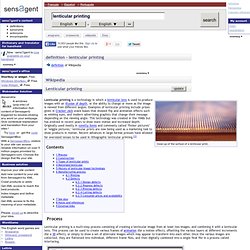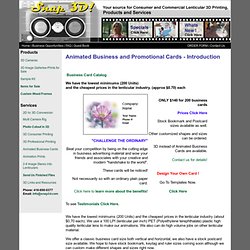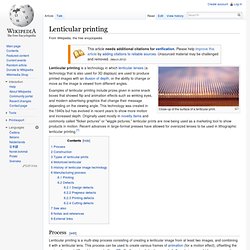

Lenticular printing : definition of lenticular printing and synonym of lenticular printing. Close-up of the surface of a lenticular print.

Lenticular printing is a technology in which a lenticular lens is used to produce images with an illusion of depth, or the ability to change or move as the image is viewed from different angles. Examples of lenticular printing include prizes given in Cracker Jack snack boxes that showed flip and animation effects such as winking eyes, and modern advertising graphics that change their message depending on the viewing angle.
This technology was created in the 1940s but has evolved in recent years to show more motion and increased depth. Originally used mostly in novelty items and commonly called "flicker pictures" or "wiggle pictures," lenticular prints are now being used as a marketing tool to show products in motion. Recent advances in large-format presses have allowed for oversized lenses to be used in lithographic lenticular printing.[1] 3D lenticular photography. 3D Business Cards - The Best of the Best 3D Lenticular Cards. Custom 3D Lenticular (holographic like) Posters. Snap 3D - 3D Lenticular Prints and Cameras. Business Card Catalog We have the lowest minimums (200 Units) and the cheapest prices in the lenticular industry.

(approx $0.70) each To see Testimonials Click Here. We have the lowest minimums (200 Units) and the cheapest prices in the lenticular industry (about $0.70 each). We use a 100 LPI (lenticular per inch) PET (Polyethylene terephthalate) plastic high quality lenticular lens to make our animations. We offer a classic business card size both vertical and horizontal, we also have a stock postcard size available. Snap3D offers full-color lenticular animation business cards that are not only spectacular marketing and sales tools, but provide visual impact. Lenticular animation business cards show a range of motion and changes in color and pattern.
These animated lenticular business cards are nearly as lightweight as paper, but durable due to the plastic construction. Take a look at these computer simulations to give you an idea of how the cards move. Use your Logo! Details Prices. Making Lenticular 3D photos and Flip pictures for home and business! Lenticular Printing - The World's Best 3D Lenticular Printer in 2D to 3D Conversion. Macworld: Human Eyes 3D. Neil Nathanson Stereoscopic Artist for Print and Animation. Brief description of lenticular technology. Though I promised do not go in any complicated details, but there is some basic information about lenticular technology should be mentioned.

As it is we know, human’s eyes see the world in three dimensions, because each eye sees the world under its particular angle of view, in other words sees the image a little bit different, not like another one. This difference is in a certain shift between the objects on a horizontal. And closer objects are shifted more, than the remote ones (picture 2.1).
Picture 2.1 Hence, it is necessary to give the left image for the left eye, and right for right one in order that the man could sense a three dimensional picture. In our case to decode the information we are going to use a lenticular lens sheet. Picture 2.2 The paper with printed interlaced image strongly fasteners by an adhesive layer with a lenticular lens sheet, and the cylindrical parallel lenses will decode the interlaced images ready for recognition of a three dimensional picture. Picture 2.3. Lenticular printing. Close-up of the surface of a lenticular print.

Lenticular printing is a technology in which lenticular lenses (a technology that is also used for 3D displays) are used to produce printed images with an illusion of depth, or the ability to change or move as the image is viewed from different angles. Examples of lenticular printing include prizes given in some snack boxes that showed flip and animation effects such as winking eyes, and modern advertising graphics that change their message depending on the viewing angle. This technology was created in the 1940s but has evolved in recent years to show more motion and increased depth. Originally used mostly in novelty items and commonly called "flicker pictures" or "wiggle pictures," lenticular prints are now being used as a marketing tool to show products in motion.
Recent advances in large-format presses have allowed for oversized lenses to be used in lithographic lenticular printing.[1] Process[edit] Construction[edit] Transforming prints.